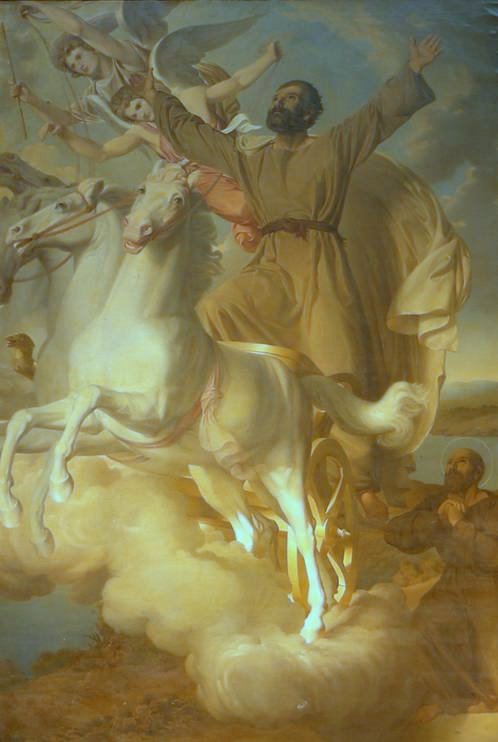
Elijah arose like a fire
The fifth reflection about the paintings by Michele Bellanti in the Church of the Annunciation, Mdina
Then Elijah arose, a prophet like fire,
and his word burned like a torch.
He brought a famine upon them,
and by his zeal he made them few in number.
By the word of the Lord he shut up the heavens,
and also three times brought down fire.
How glorious you were, Elijah, in your wondrous deeds!
Whose glory is equal to yours?
You were taken up by a whirlwind of fire,
in a chariot with horses of fire.
At the appointed time, it is written, you are destined
to calm the wrath of God before it breaks out in fury,
to turn the hearts of parents to their children,
and to restore the tribes of Jacob.
Happy are those who saw you
and were adorned with your love!
For we also shall surely live.
Sirach 48:1-4, 9-11
We now move on from the rather tranquil scene of the Blessed Virgin giving the Scapular to St Simon Stock, to the frenzied scene in which the same artist presents the prophet Elijah being taken up to heaven by a whirlwind of fire. The Carmelite Order is one of the few monastic orders, if not the only one, not to refer to a charismatic leader as its founder, but to a prophet of the Old Testament: Elijah, who is considered by the Carmelites as the spiritual father of the order.
Tradition indicates the presence on Mount Carmel of a series of Jewish and then Christian hermits who lived, prayed, and taught in the caves used by the Prophet Elijah, as narrated in the First Book of Kings. It seems that at the beginning of the thirteenth century these hermits requested to be given a rule and they also built a chapel dedicated to Mary, Star of the Sea. It was this chapel that bound the Order to Mary.
The dramatics in Bellanti’s work captures the account provided in the second chapter of the Second Book of Kings, which concludes the narrative about Elijah and opens that about Elisha, not as a disciple of the prophet anymore, but as a prophet in his own right. Bellanti is not entirely faithful to the biblical story which speaks of “a chariot of fire and horses of fire” (2 Kings 2:11). Instead, Bellanti paints a golden chariot pulled by four white horses, seemingly lifted off by a cloud—which probably represents the whirlwind that took up Elijah.
What became of Elijah is not specified. Before he died, Mattathias the Maccabee said to his sons that “Elijah because of great zeal for the law was taken up into heaven” (1 Mac 2:58). Certainly, over time Elijah grew into a central figure in the evolution of Messianic theology. So much so, that Malachi’s prophecy—“Behold, I will send you Elijah the prophet before the great and terrible day of the Lord comes” (Mal 4: 5)—gave rise to the idea that Elijah would return prior to the coming of the Messiah. Jesus too espouses this notion, perceiving Elijah in John the Baptist (Mt 17:10-13). Although Bellanti appears to overlook Elijah’s prophetic potency denoted by fire, he definitively counterbalances that by the shine around the chariot which resembles the radiance and whiteness at the Transfiguration. On a personal level, apart from the prophetic power and simplicity that ought to characterise authentic Christian life, may Elijah’s gaze, intently fixed upwards, and his spirit burning like a fire, also arouse us to let the Lord change us from one degree of glory to another, until we enter into our heavenly inheritance (see 2 Cor 3:18).



